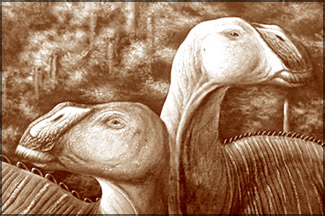
Duck-billed dinosaur amazes scientists
Scientists are amazed at
the chomping (chewing) ability of a newly described duck-billed
dinosaur. The herbivore's powerful jaw, more than 800 teeth and compact
skull meant that no leaf, branch or bush would have been safe, they say.
"It really is like the Arnold Schwarzenegger of dinosaurs - it's all
pumped up," said Scott Sampson, curator of the Utah Museum of Natural
History.
The newly named Gryposaurus monumentensis, or hook-beaked lizard from
the monument, was discovered
|

The newest dinosaur species according to a rendering made
available by artist Larry Felder and the University of Utah. |
near the Arizona line in the Grand Staircase-Escalante National
Monument in 2002 by a volunteer at the site.
Details about the 75-million-year-old dinosaur, including its name,
were published in the October 3 edition of Zoological Journal of the
Linnean Society. Duck-billed dinosaurs were previously known to have
been among the most imposing herbivores, with hundreds of teeth and a
body that could knock down trees.
Gryposaurus monumentensis, at least 30 feet long and 10 feet tall
with a robust (strong) jaw and thick bones, was like a duck-billed
dinosaur on steroids, said paleontologist Terry Gates. "It's basically
the Cretaceous version of a weed-whacker," he said. "You have a very
formidable (fearsome) herbivore."
Although paleontologists said that the dinosaur could eat just about
any plant it wanted, scientists still aren't sure what it dined on.
Southern Utah is now a rocky desert with few trees, but 75 million years
ago, it was a dinosaur haven that looked something like Louisiana today,
Gates said.
"It's very humid and wet, with lots of ponds and lots of rivers and
creeks flowing through it. It was very lush," he said.
The discovery of new species, including Gryposaurus monumentensis,
will help scientists understand more about what the earth was like
millions of years ago, he said.Sampson said duck-billed dinosaurs once
lived throughout the northwestern part of North America.
The newly discovered version has a smaller skull that allowed it to
apply more force to what it was eating." By shortening the skull, you
can get more power per bite. The shrinking of the skull and the
robustness(strength) of the jaw and snout all lead me to think this guy
was made to eat," Gates said.
However, the duck-billed dinosaur's teeth and size would not have
been much of a defense against area predators such as the tyrannosaur.
Scientists also aren't sure if the new dinosaur was a loner or travelled
in herds for protection because so few skeletal remains have been found.
It's one of several questions scientists are hoping to answer, along
with how and why different species of the duck-billed dinosaur
developed.
AP |
